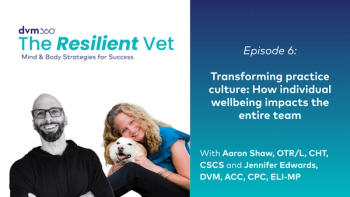
Envisioning a better tomorrow for the veterinary profession
No one changes their life because of fear, force, or facts.
Rcently I had the privilege of sitting in on the IDEXX Practice Management Consultant Summit held in mid-February. During the event Dr. Karen Felsted, MBA, CVPM, made a comment that lodged in my brain and has been there ever since. The statement was this: People are not motivated to change by fear, force, or facts. What motivates them to change is the ability to envision a better tomorrow.
Kristi Reimer
I asked Dr. Felsted to send me the article from which she'd drawn that conclusion, which she readily did. "Change or Die," by Alan Deutschman (FastCompany, May 2005), is built around an astonishing statistic: Ninety percent of people who undergo coronary bypass surgery do not—will not, cannot—adopt a healthier lifestyle, even though they fully understand that their sedentary ways and fatty diet will most likely kill them.
Here's the central question posed by the article: "Why, in general, is change so incredibly difficult for people? What is it about how our brains are wired that resists change so tenaciously? Why do we fight even what we know to be in our own vital interests?" I encourage you to read Deutschman's article (Google "change or die fastcompany") for a thorough exploration of this question, but in essence it comes down to this: Joy is a more powerful motivator than fear. More specifically, for any kind of information (or "story") to bring about change, it must be simple, easy to identify with, emotionally resonant, and evocative of positive experiences. Even the coolest, most analytical personalities among us are driven by emotion more than rationality.
We've been dealing with some unpleasant realities in the veterinary profession recently—declining patient visits, falling clinic revenue, diminishing practice values—accompanied by a wealth of fear-inducing data implying that if we don't change we'll die. It's pretty bad. The situation is urgent. The profession may even be in jeopardy, analysts tell us. While it may be true, I know how I feel when someone tells me I'm doing a bad job and that things will get worse if I don't shape up. I don't imagine you're terribly inspired by this message either. So if fear and facts aren't going to drive change, what will? What is the joy of our profession's better tomorrow?
Here I have to hand it to Dr. Marty Becker, who understands inspiration better than just about anyone else in the industry (all while cleverly disguising the fact that he's a whip-smart marketing genius). Dr. Becker's "story" of the human-animal bond is simple, easy to identify with, and emotionally resonant. I've heard his stories often enough that I can tell them myself, but still, all he has to do is evoke "the rusty sound of a kitten's purr" and I'm off to take my cat in for her annual exam. He helps me envision a better tomorrow with my pet for as long as possible.
I imagine that your joy involves protecting your patients' health more effectively and for as long as possible. Here at Veterinary Economics we'll continue to present the facts that point to a need for change, but we'll minimize the fear-mongering (as we've always tried to do), and we'll do our best to paint all the possibilities of what a brighter tomorrow might entail.
Kristi Reimer, Editor
Newsletter
From exam room tips to practice management insights, get trusted veterinary news delivered straight to your inbox—subscribe to dvm360.




